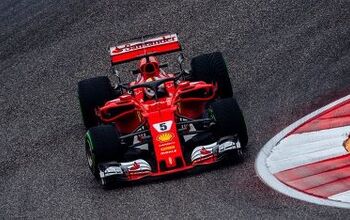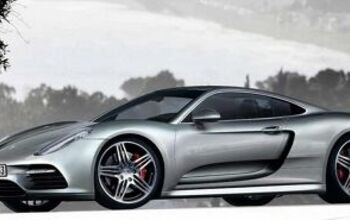Ferrari's Engine Problem
It’s no secret that Ferrari has been wrestling with the inevitable conflict between its bellowing V12s and European emission regulations, but that’s not the only challenge facing the Prancing Horse’s powertrain division. Sure, there’s the increasingly-tenuous link between the Scuderia’s Formula One technology and its road cars [sub], but in the short term that actually helps the emissions issue by creating a pretext for bringing KERS to the road (where it otherwise has little role). In fact, the real issue for Ferrari’s powertrain team is not even a “Ferrari issue” at all, but a Maserati issue.
One of the keys to Maserati’s success as a brand, is the fact that its engines are supplied by Ferrari, a “secret” kept by precisely nobody and referenced in every Maserati review ever written. And considering that Ferrari has to limit its production to 7,000 units in order to maintain exclusivity, it’s not a bad way to build scale on such limited-production engines. The problem is this: with Ferrari unable to grow its volume (instead, focusing purely on profits), Maserati has to. Thus, the new plan to build 40,000 new Maseratis per year by 2014, up from 5,700 cars sold in 2010. About 20k units of that volume are expected to be Kubang SUVs, and the rest will come from two sedans that straddle the current Quattroporte. The Kubang will come with Maser’s 4.7 liter V8, and the two sedans will use direct-injected V6 twin-turbo or V8 engines, also developed and built by Ferrari. Maserati CEO Harald Wester tells evo Magazine (print edition)
Paolo Martinelli [Maserati’s powertrain boss and a previous engine chief for the Ferrari F1 team] is developing these new engines right now in Maranello, and Ferrari will be producing them exclusively for Maserati.
And, admits Wester that will present some serious challenges, as Maserati is talking about a seven-fold increase in engine demand.
If we need 30,000 Ferrari engines, the project is different. The set-up is perfect in terms of quality, but Ferrari will have to do something significant to be able to supply us with the engines we will require in the future.
But how does Ferrari ramp up to make seven times as many engines without losing any quality or exclusivity? Here’s where the story gets strange, as evo reports
Ferrari is already investigating working double shifts in its engine plant as a way to increase production
…and that’s it. Now, I don’t know enough about Ferrari’s powertrain plant to know whether it’s possible to get seven times the volume by switching to a double shift, but it sure sounds like a challenge. And if nothing else, it certainly takes a little of the exclusivity out of the Ferrari brand. But then, a slightly-less exclusive Ferrari is probably more than worth it when you multiply Maserati’s profits margins by 40,000. In any case, we’ll be curious to see how Ferrari manages this situation going forward.
More by Edward Niedermeyer
Latest Car Reviews
Read moreLatest Product Reviews
Read moreRecent Comments
- Theflyersfan I know given the body style they'll sell dozens, but for those of us who grew up wanting a nice Prelude Si with 4WS but our student budgets said no way, it'd be interesting to see if Honda can persuade GenX-ers to open their wallets for one. Civic Type-R powertrain in a coupe body style? Mild hybrid if they have to? The holy grail will still be if Honda gives the ultimate middle finger towards all things EV and hybrid, hides a few engineers in the basement away from spy cameras and leaks, comes up with a limited run of 9,000 rpm engines and gives us the last gasp of the S2000 once again. A send off to remind us of when once they screamed before everything sounds like a whirring appliance.
- Jeff Nice concept car. One can only dream.
- Funky D The problem is not exclusively the cost of the vehicle. The problem is that there are too few use cases for BEVs that couldn't be done by a plug-in hybrid, with the latter having the ability to do long-range trips without requiring lengthy recharging and being better able to function in really cold climates.In our particular case, a plug-in hybrid would run in all electric mode for the vast majority of the miles we would drive on a regular basis. It would also charge faster and the battery replacement should be less expensive than its BEV counterpart.So the answer for me is a polite, but firm NO.
- 3SpeedAutomatic 2012 Ford Escape V6 FWD at 147k miles:Just went thru a heavy maintenance cycle: full brake job with rotors and drums, replace top & bottom radiator hoses, radiator flush, transmission flush, replace valve cover gaskets (still leaks oil, but not as bad as before), & fan belt. Also, #4 fuel injector locked up. About $4.5k spread over 19 months. Sole means of transportation, so don't mind spending the money for reliability. Was going to replace prior to the above maintenance cycle, but COVID screwed up the market ( $4k markup over sticker including $400 for nitrogen in the tires), so bit the bullet. Now serious about replacing, but waiting for used and/or new car prices to fall a bit more. Have my eye on a particular SUV. Last I checked, had a $2.5k discount with great interest rate (better than my CU) for financing. Will keep on driving Escape as long as A/C works. 🚗🚗🚗
- Rna65689660 For such a flat surface, why not get smoke tint, Rtint or Rvynil. Starts at $8. I used to use a company called Lamin-x, but I think they are gone. Has held up great.

































Comments
Join the conversation
wabbout a Cryco V6 or a pushrod hemi V8 for Maserati ?